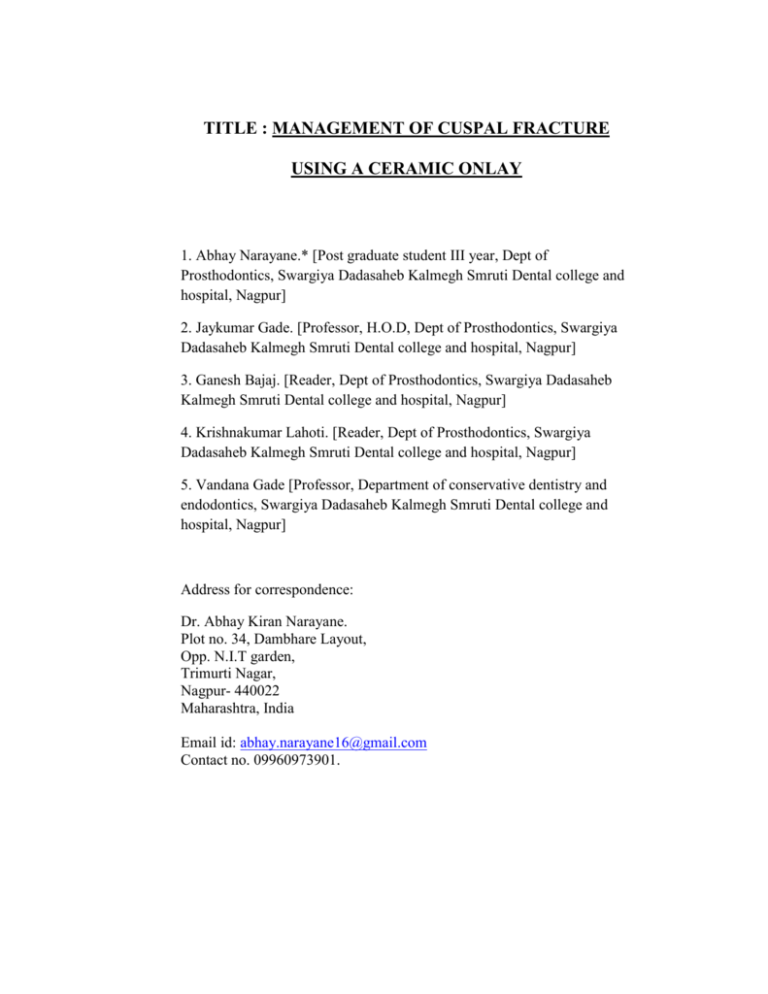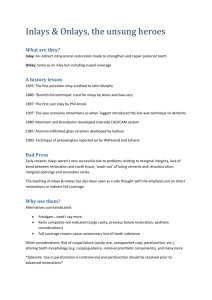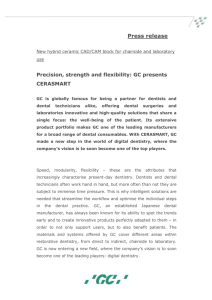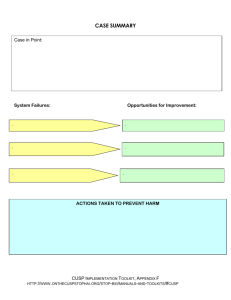cntctfrm_a678646800ffadab3c0ae3a2ba7f5c0a_onlay article
advertisement

TITLE : MANAGEMENT OF CUSPAL FRACTURE USING A CERAMIC ONLAY 1. Abhay Narayane.* [Post graduate student III year, Dept of Prosthodontics, Swargiya Dadasaheb Kalmegh Smruti Dental college and hospital, Nagpur] 2. Jaykumar Gade. [Professor, H.O.D, Dept of Prosthodontics, Swargiya Dadasaheb Kalmegh Smruti Dental college and hospital, Nagpur] 3. Ganesh Bajaj. [Reader, Dept of Prosthodontics, Swargiya Dadasaheb Kalmegh Smruti Dental college and hospital, Nagpur] 4. Krishnakumar Lahoti. [Reader, Dept of Prosthodontics, Swargiya Dadasaheb Kalmegh Smruti Dental college and hospital, Nagpur] 5. Vandana Gade [Professor, Department of conservative dentistry and endodontics, Swargiya Dadasaheb Kalmegh Smruti Dental college and hospital, Nagpur] Address for correspondence: Dr. Abhay Kiran Narayane. Plot no. 34, Dambhare Layout, Opp. N.I.T garden, Trimurti Nagar, Nagpur- 440022 Maharashtra, India Email id: abhay.narayane16@gmail.com Contact no. 09960973901. Abstract It is always a challenge for clinicians when a missing functional cusp of a posterior tooth has to be replaced. In the past, pins were used to retain the restoration, but the remaining cusp tended to become weak and fractured during axial loading. With improvements in adhesive techniques we can now offer more-conservative treatment for patients. Using a ceramic onlay excludes the disadvantages of amalgam, cast restorations and composites by providing esthetics as well as strength The ceramic pressing technique has the advantage of giving an excellent marginal adaptation which is the key to success for any restoration. Keywords: cusp fracture, onlay, ceramics Introduction: The incidence tooth fractures is quite common; it particularly occurs in teeth with large intracoronal restorations.1 There have been several studies analyzing different restorative materials for restoring severely compromised teeth1-4. Segura et al.2 evaluated the fracture resistance of 4 different restorations for cuspal replacement on human extracted molars. Their results revealed that composite resin restorations with an adhesive had higher values of fracture resistance than did other restorative techniques, while a self-threading pin decreased the fracture resistance. Macpherson2 also concluded that pin-retained amalgam had less fracture resistance. Studies by Pilo et al.3 showed that amalgam adhesives might contribute to strengthening weakened cusps and revealed good marginal adaptation. One has to minimize reductions in the buccal-palatal width of the buccal cusp to prevent cusp fracture and preserve the residual coronal tooth structure. Therefore, a direct onlay restoration should be a better choice than a crown. With improvements in dental adhesive systems, bonded ceramic restorations are recognized as an alternative to direct restorations.5 In this case report, a maxillary molar with a non-functional cusp that had been fractured has been replaced with a ceramic onlay and cemented with resin adhesive. Clinical report: A 30-year-old female patient reported to the Department of Prosthodontics, SDKS College and Hospital, Nagpur, Maharashtra, India, with the complaint of a broken tooth in the upper left back region of the jaw. Clinical examination: Intraoral examination revealed a fracture of the mesiobuccal cusp including the mesial marginal ridge of the upper left first molar. (#26). (Figure 1, 2). An electric pulp test (EPT) test, was done to determine the vitality of this tooth which was found to be positive, and she reported no discomfort. She only complained of hypersensitivity when consuming hot or cold drinks. An x-ray examination of #26 revealed no caries or pulpal involvement. The supporting bone was intact without periodontal ligament widening or an apical lesion. Figure 1: occlusal view showing fractured mesiobuccal cusp of #26 Figure 2: buccal view showing fractured mesiobuccal cusp of #26 Treatment plan: Based on conventional concepts, a crown had to be fabricated, and a buccal cusp had to be prepared, that would require sacrificing a lot of tooth structure. Under such circumstances, if it was restored with pinretained amalgam or a composite resin, a tooth fracture was likely to occur again. Another option was crown construction, but more tooth structure would have to be removed, and root canal treatment might be required. Under these circumstances, an onlay restoration is an appropriate option. At present there are mainly 3 kinds of materials available: cast metal, ceramic, and resin reinforcement. Cast metal would be visible and could not be applied to the mesiobuccal cusp of the molar because of esthetic reasons. In comparison, the wear-resistance, flexural strength, and color durability of ceramic are superior to those of resin reinforcement.6 Therefore, ceramic onlay fabrication was chosen because of its durability, performance, and precision as well as esthetics. Treatment procedure: The cavity was prepared only along the original defect area, without placing any mechanical undercutting to weaken the tooth structure. All margins had a 90° butt-joint cavosurface angle. All line and point angles were rounded to avoid stress being concentrated on the restoration and tooth. (Figure 3, 4) Figure 3: occlusal view showing preared tooth #26 Figure 4: buccal view showing showing preared tooth #26 The Impression was made using addition silicone elastomer using the single step impression technique (Putty and lightbody) (Figure 5). Figure 5: elastomeric impression Figure 6: wax pattern fabricated on die The impression was poured in type IV dental stone. Die curtting was done and a wax pattern was fabricated (Figure 6) and invested. Pressing was done using “Multimat II touch and press” ceramic pressing machine. Figure 7: Divested onlay Figure 8: Divested onlay seated on die Figure 9 : Buccal veiw of finished onlay Figure 10 : occlusal veiw of finished finished onlay The onlay was divested carefully and finished (Figure 7, 8, 9, 10). Then it was seated in the patients mouth and the occlusion was checked for. Eccentric contacts were removed. The finished and polished ceramic onlay was cemented using a dual cure resin cement. The internal surface of the ceramic restoration was etched with 4% hydrofluoric acid (IPS Ceramic Etching Gel, Ivoclar Vivadent AG, Schaan, Liechtenstein) for 5 minutes, silanated with Mono- bond S (Variolink, Ivoclar Vivadent AG, Schaan, Liechtenstein), and covered with Helibond (Variolink, Ivoclar Vivadent AG, Schaan, Liechtenstein). The cavities were etched with 37% phosphoric acid, and a dentin-bonding agent was applied to the cavities (Syntac classic, Ivoclar Vivadent AG, Schaan, Lie- chtenstein). Then the ceramic restoration was seated using light pressure with a ball burnisher. Excess composite resin was removed with a thin- bladed composite instrument or an explorer. The cement was light-cured from each direction for an exposure of at least 60 seconds. Finishing and polishing of the restorations was done using a series of fine diamond instruments and 30-fluted carbide finishing burs under air-water spray (Figure 11, 12). Figure 11: Occlusal view of ceramic ceramic cemented onlay Figure 12: Buccal view of cemented onlay Discussion: In cases of large decay or loss of the entire cusp, the restorative procedure becomes more challenging. The choice of restorative material or technique might influence the success or failure of the treatment. Ideally, when a multisurface cavity involves the entire cusp, full coverage with a crown or onlay restoration is the best choice. In addition, margin adaptation is often deemed a critical factor in the longevity of indirect restoration. Recently, the bond strength of resin cement has been improved, and the margin adaptation of the restorations using the pressing technique is known to give the best results. After cementing the ceramic onlay, appropriate occlusal adjustment is a key point for success. Static and dynamic occlusal relationships should be checked for before preparation to ensure that the biting force will not concentrate on the junction between the tooth and the restoration. Risk indicators for cusp fracture, including bruxism and worn teeth, a steep cuspal anatomy, traumatic occlusal relationships, etc. should be diagnosed and eliminated as well as the design and material should be chosen accordingly. Conclusion: when faced with a tooth with extensive destruction or a fractured cusp but intact pulp, we may consider choosing the ceramic onlay for restoration that is not only has strength but is provides excellent esthetics. However, careful case selection and optimal clinical procedures are keys to success. References: 1. Macpherson LC, Smith BGN. Replacement of missing cusps: an in vitro study. J Dent, 22: 118-120, 1994. 2. Segura A, Riggins R. Fracture resistance of four different restorations for cuspal replacement. J Oral Rehabil, 26: 928-931, 1999. 3. Pilo R, Brosh T, Chweidan H. Cusp reinforcement by bonding of amalgam restorations. J Dent, 26: 467-472, 1998. 4. Franchi M, Breschi L, Ruggeri O. Cusp fracture resistance in composite-amalgam combined restorations. J Dent, 27: 47-52, 1999. 5. Sven MR, Manfred W, Heiner R, Adrian S. Clinical performance of large, all-ceramic CAD/CAM-generated restorations after three years A pilot study. J Am Dent Assoc, 135: 605-612, 2004. 6. Edward JS, John RS, Andre VR. Classes I and II indirect toothcolored restorations. In “Sturdevant's Art & Science of Operative Dentistry” 4th ed, Theodore MR, Mosby Co, St. Louis, USA, pp. 569-590, 2002.



